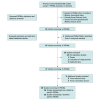Use of Patient-Reported Outcome Measures to Assess Outpatient Postpartum Recovery: A Systematic Review
- PMID: 34042993
- PMCID: PMC8160591
- DOI: 10.1001/jamanetworkopen.2021.11600
Use of Patient-Reported Outcome Measures to Assess Outpatient Postpartum Recovery: A Systematic Review
Abstract
Importance: Outpatient postpartum recovery is an underexplored area of obstetrics. There is currently no consensus regarding which patient-reported outcome measure (PROM) clinicians and researchers should use to evaluate postpartum recovery.
Objective: To evaluate PROMs of outpatient postpartum recovery using Consensus-Based Standards for the Selection of Health Measurement Instruments (COSMIN) guidelines.
Evidence review: An initial literature search performed in July 2019 identified postpartum recovery PROMs and validation studies. A secondary search in July 2020 identified additional validation studies. Both searches were performed using 4 databases (Web of Science, Embase, PubMed, and CINAHL), with no date limiters. Studies with PROMs evaluating more than 3 proposed outpatient postpartum recovery domains were considered. Studies were included if they assessed any psychometric measurement property of the included PROMs in the outpatient postpartum setting. The PROMs were assessed for the following 8 psychometric measurement properties, as defined by COSMIN: content validity, structural validity, internal consistency, cross-cultural validity and measurement invariance, reliability, measurement error, hypothesis testing, and responsiveness. Psychometric measurement properties were evaluated in each included study using the COSMIN criteria by assessing (1) the quality of the methods (very good, adequate, doubtful, inadequate, or not assessed); (2) overall rating of results (sufficient, insufficient, inconsistent, or indeterminate); (3) level of evidence assessed using the Grading of Recommendations, Assessment, Development and Evaluations assessment tool; and (4) level of recommendation, which included class A (recommended for use; showed adequate content validity with at least low-quality evidence for sufficient internal consistency), class B (not class A or class C), or class C (not recommended).
Findings: In total, 15 PROMs (7 obstetric specific and 8 non-obstetric specific) were identified, evaluating outpatient postpartum recovery in 46 studies involving 19 165 women. The majority of psychometric measurement properties of the included PROMs were graded as having very-low-level or low-level evidence. The best-performing PROMs that received class A recommendations were the Maternal Concerns Questionnaire, the Postpartum Quality of Life tool, and the World Health Organization Quality of Life-BREF. The remainder of the evaluated PROMs had insufficient evidence to make recommendations regarding their use (and received class B recommendations).
Conclusions and relevance: This review found that the best-performing PROMs currently available to evaluate outpatient postpartum recovery were the Maternal Concerns Questionnaire, the Postpartum Quality of Life tool, and the World Health Organization Quality of Life-BREF; however, these tools all had significant limitations. This study highlights the need to focus future efforts on robustly developing and validating a new PROM that may comprehensively evaluate outpatient postpartum recovery.
Conflict of interest statement
Figures
Comment in
-
Deconstructing Current Postpartum Recovery Research-The Need to Contextualize Patient-Reported Outcome Measures.JAMA Netw Open. 2021 May 3;4(5):e2111689. doi: 10.1001/jamanetworkopen.2021.11689. JAMA Netw Open. 2021. PMID: 34042997 No abstract available.
References
-
- The World Counts. How many babies are born each day. Published 2020. Accessed August 27, 2020. https://www.theworldcounts.com/stories/How-Many-Babies-Are-Born-Each-Day...
Publication types
MeSH terms
LinkOut - more resources
Full Text Sources
Other Literature Sources
Medical


